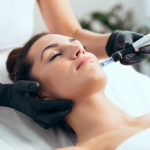Photo By Nicolas Orallo at Shutterstock
Male or female-pattern baldness affects approximately 50 million men and 30 million women in the United States. Hair loss usually begins after age 50, but it can occur much earlier. Self-worth does not revolve around physical appearance, but baldness can negatively affect emotional and mental health.
Men and women have reported depression and discomfort during social interaction due to hair loss and baldness. Platelet-rich plasma, or PRP, is a fairly new treatment for baldness and thinning hair. The treatment is very similar to microneedling with PRP to rejuvenate skin. PRP injections are available in Southlake, TX, and the procedure is rapidly gaining popularity throughout the field of dermatology.
Is PRP Safe?
PRP was originally developed to enhance healing for people recovering from injuries or reconstructive surgery. It accelerates healing in muscles, tendons, and joints. The FDA evaluates medications and treatments in the United States to ensure safety and effectiveness before they are available to the public. PRP is used ‘off-label’ to reverse hair loss. “Off-label” means the FDA verified PRP for its original use and determined that benefits outweigh the risks when it is used for another purpose. Doctors in Southlake, TX, can recommend platelet-rich plasma treatments if they believe it will help their patients.
A determination that “benefits outweigh the risks” sounds slightly ominous, but the criteria applies to all medications and treatments. An ‘off-label’ treatment with negative side effects may be used for a serious illness because the illness is a greater threat to health and quality of life. Baldness is not life-threatening, and it does not significantly affect daily life. Treatments with potentially serious side effects are not approved to treat hair loss in dermatology.
PRP injections are very safe. There is no risk of an immune response because the plasma comes from the client’s blood. Infection is the most serious potential risk. Choose a reputable dermatology clinic with knowledgeable staff in Southlake, TX, to minimize risk of infection.
The two main components in blood are red blood cells and plasma. Plasma contains white blood cells, or WBCs, and platelets that are rich in growth factors that promote healing. The concentration of growth factors, platelets, WBCs, and proteins in platelet-rich plasma is five to ten times higher than the concentration in blood.
The platelets and growth factors also encourage vascularization, the growth of new blood vessels, around injection sites. Additional blood vessels improve circulation in the scalp. Vascularization promotes hair growth because follicles have more access to oxygen and other nutrients in the blood.
PRP Injection Procedure
Platelet-rich plasma used in dermatology is derived from the client’s blood. Medical staff draw blood from the arm and place the tube of blood in a centrifuge. The centrifuge rapidly spins the tube until red blood cells and plasma separate into two distinct layers.
A doctor at a dermatology clinic injects PRP plasma into the scalp at half-inch increments. The procedure takes approximately 20 minutes from start to finish. Most people experience very little pain and feel light pressure from the injections. Anesthesia is not necessary, but cool air or ice minimizes discomfort.
PRP injections are administered once a month for three or four months, then drop to one procedure every three to six months. Clients usually notice less hair shedding within two to three months. Hair regeneration typically begins during the third or fourth month.
Side Effects and Aftercare
Most side effects of PRP treatment are very mild. Scalp tenderness after the procedure is common. Sometimes temporary bleeding occurs at injection sites, but bleeding usually stops before clients leave the dermatology clinic. Other side effects include swelling, mild pain around injection sites, and itching.
Clients can take over-the-counter medications to relieve mild pain after PRP injections. There are no limitations on daily activities after the procedure. A warm shower soothes lingering discomfort and enhances blood circulation in the scalp.
Avoid coloring, blow-drying, processing, or applying hair care products for one or two days to avoid irritating the injection sites. Clients taking anticoagulant medication should ask a doctor about taking the medication on the day of the procedure.
How Well Does PRP Work?
Numerous studies have confirmed the effectiveness of PRP injections for stopping and reversing hair loss. A review of research during 2019 in the journal ‘Aesthetic Plastic Surgery’ found that PRP injections reduced hair loss and increased hair density and diameter of individual strands. A systematic review in the ‘Dermatologic Surgery Trusted Source’ looked at results of 19 studies. Reviewers found that most studies reported successful hair regeneration in people with androgenetic alopecia.
Greek researchers at Democritus University monitored 20 people treated with PRP and found that hair volume increased significantly. PRP is not a permanent cure. Clients need to schedule maintenance treatment. Doctors in dermatology have not settled on a standardized schedule for long-term maintenance treatment yet. Many dermatology clinics recommend PRP injections every 3 months after hair loss has stopped and new growth is stabilized.
Who Can Benefit from PRP Treatment?
Men and women with androgenetic alopecia are great candidates for PRP treatment in Southlake, TX. Androgenetic alopecia is a genetic condition that causes shrinking in hair follicles. It is referred to as male pattern baldness in men.
Damaged follicles produce less hair overall, and the hair that does grow is thin and fragile. PRP injections are frequently used in dermatology to reverse this condition. Concentrated growth factors in PRP encourage healing and tissue repair in shrunken follicles.
Anyone experiencing hair loss can consult Compassionate Dermatology in Southlake, TX. Helpful and friendly professionals work with clients to figure out why they are losing hair. PRP injections can be used in combination with other interventions, such as nutrition therapy or medication, to keep hair healthy and vibrant.


